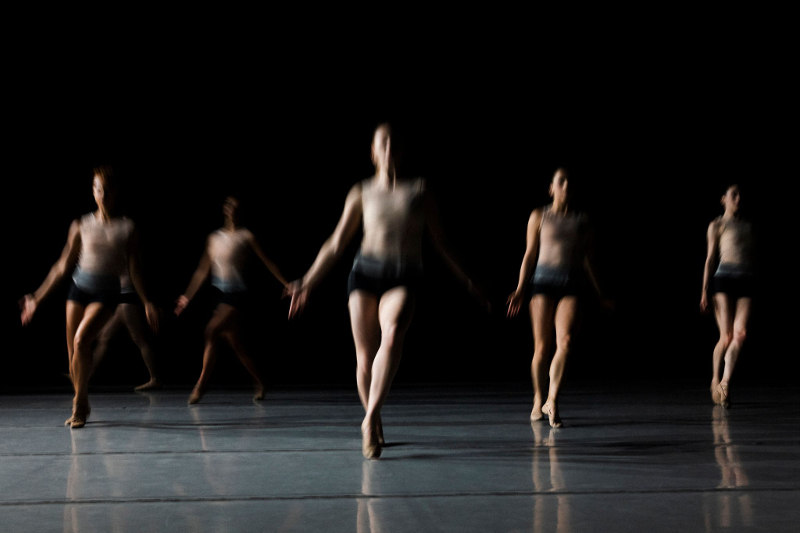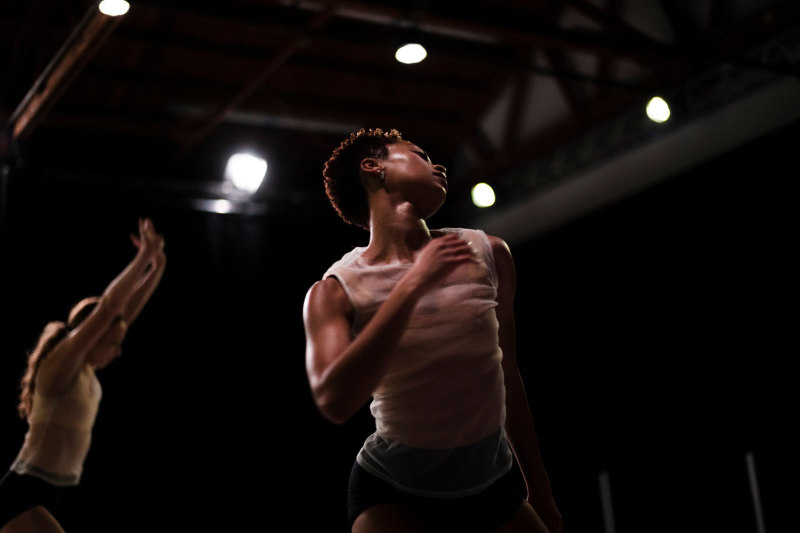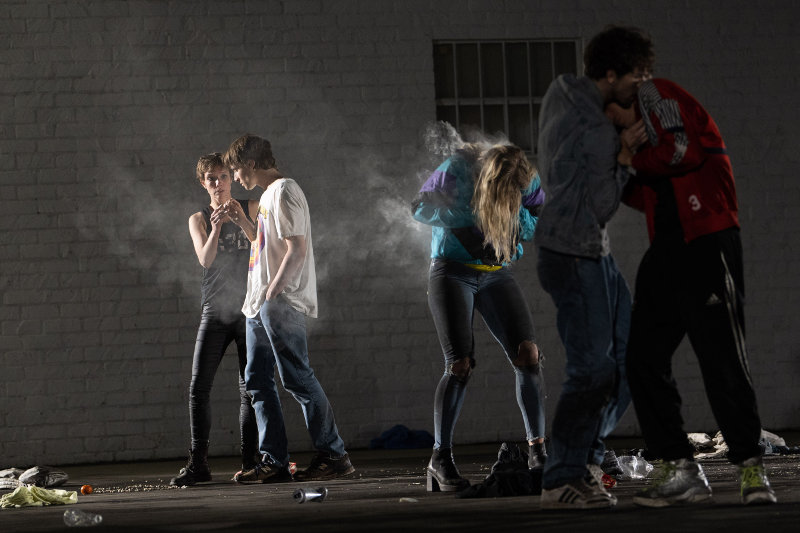
It was quite an evening. As part of an elite, invited audience hosted by France’s sui generis luxury jewelry purveyor, Van Cleef & Arpels, I attended a specially curated program delivered under the rubric of “Dance Reflections,” the retailer’s newish dance initiative. (It had a big rollout in London this past spring.) The evening took place at the headquarters of L.A. Dance Project in downtown Los Angeles. It comprised separate presentations by two disparate (but both French) choreographers, Benjamin Millepied and Gisèle Vienne. In baseball terms we had a double header–only, champagne and caviar were served.
First announced by Van Cleef in 2020 (aka the performing arts world’s annus horribilis), the stated aim of Dance Reflections is to “bring contemporary works to as many people as possible.” That is a direct lift from their marketing materials and a pretty broad mission. Van Cleef’s foray into dance-doings is not new. The passion for rare stones that Claude Arpels, a balletomane, shared with George Balanchine, it is claimed, led to Mr. B.’s creation of his three-act ballet masterwork, Jewels (1967). It’s not clear what Millepied’s precise business relationship with Van Cleef entails, but since 2012 Mr. Millepied has been in some form of partnership with the jewel purveyor. Also since that time, Natalie Portman, Mr. Millepied’s wife [update: 2024, the couple has divorced], has been seen adorned by Van Cleef in various red-carpet moments. She’s beautiful and she wears the jewelry well. Several months ago, Van Cleef & Arpels advertised in the New York Times Magazine that they’d made a watch with a bejeweled ballet dancer dancing through the hours. This is balletomania!

The performance was my first glimpse of L.A. Dance Project in a few years, mostly due to COVID but also because I have not admired Mr. Millepied’s work in the past. Thursday night, I was deeply struck that he has wonderful dancers. That says much about him: selecting dancers is a choreographer’s starting point in giving form to his or her vision. So, Millepied’s fine eye in this regard bears mention. Head shots of the company’s 18 dancers (that’s a lot!) are featured in a studio wall-display, and that is a nice touch. They’re contemporary stylists, with robust balletic underpinning, as such, highly versatile movers. I was next struck by how very diverse is this dance company. Yes, it is racially diverse. But it is also diversified by size and shape; by performance aura (some are reclusive, others extroverted); and, in a pleasing way, one senses that Mr. Millepied encourages their personalities to shine through. My frank recall of this troupe in its early days was rather the opposite. I remember dancers as dutiful tools. Not so the case last Thursday night.
The parts of Be Here Now that I really liked were tethered to form. I’m carting around a COVID-confused brain, I’ll admit that. But I always like dances that signal a lot of structural underpinning. In Be Here Now, Millepied arranges lines formations, and other groupings — and their intersections — so well. He opens the work with an all-female quartet (Sierra Herrera, Daphne Fernberger, Daisy Jacobson, Nayomi Van Brunt) dressed in little dance shorts, diaphanous tops, and soft ballet slippers. To the sound of plucking violin strings, the ladies form a diamond shape and take little hops and skips, much in unison, with a delicacy and soft edge I find appealing. The ladies move en masse — but the masse had lightness to it This movement spools to intriguing music, “Entr’acte,” by a woman composer, Caroline Shaw.
Onto the stage area arrived five men to the sound of syncopated drumming — excerpts from Andy Akiho’s Grammy and Pulitzer Prize-nominated, “Seven Pillars.” Millepied poured forth very active and kinetic choreography. A marvelous male dancer with blonde hair and tattoos motored to the African-inflected beat, spinning balletic turns in a tight fifth position. There was a vee-formation of the guys on the right, and a straight line of women on the left; then followed playful partnering. A return to primitive stomping steps. Two men in a duet, their torsos flopping over their legs in a rag-doll dance. One man put his full figure on top of the prone body of the other and there, they took a breather. (Didn’t look too relaxing.) A high-velocity episode of partnered dancing ensued with *very* arduous ballet technique — and you could hear their panting breath.
A slender lady soloed — taking very big steps with her very long legs, reacting to music’s minutia, little computer bleeps. A duet for a Black male dancer and a fabulous petite female one, was amusing for their size differences. Both were impressive, but she demonstrated of how very good ballet technique enables lots of off-balance stuff. It was in this duet, I believe, that the big trick of the evening occurred: she jumps in place, upward, in a saute de basque, tucking feet beneath her and in he swoops, grabbing her by the waist, in essence, catching her, mid-air, in a stationary, not a traveling moment. That’s very hard to do. And on and on it went. The dancers, one felt, grew aware that they were crushing it. There were many smiles.
So, what’s not to like? Where Millepied is concerned, it’s an abundance of riches. Benjamin Millepied knows a lot of steps. A lot!! Hundreds, could be thousands! That observation is made in good faith, in recognition, and with respect. As a former New York City Ballet principal and former artistic director, however briefly, at Paris Opera Ballet, this is his heritage. Millepied’s depth of knowledge of the classical ballet vernacular may be among the most advanced now at work in the field. It makes him exceptional. He has, tucked in his back pocket, all kinds of ‘guy’ ballet tricks — ready to deploy. I do hope the men dancing for him appreciate this. He seems to have taught them ALL kinds of stuff. Barrel turns and tours en l’air that land in new ways. The leaping, by the men, is thrilling, especially in the way they nonchalantly dole it out.
It seems crazy to find in Millepied’s gift a shortcoming. But his surfeit of steps has a flip side. I sat for an hour of this high voltage spew — and it left me perplexed. It’s a little this, a little that, it’s all mixed in, and it’s kind of confusing to watch. We all know that dance speaks a mysterious language. But Millepied’s is notably hither and yon. It is jam packed. It’s bravura. It’s sexy. It’s smart. It’s show-offy. It’s fresh, even musical! But it doesn’t add up; often it tapers off … and then a new idea gets expressed. So it doesn’t make physical sense, it doesn’t go anywhere and it’s hard to watch–certainly for an hour.

photo by Josh Rose
A second point. I am wary of the privatization of dance presentation. A private firm in the for-profit space operates in a black box, no transparency. So we can never know (nor do we have the right to even ask) how artists are selected, who does the selection, by what qualification he who vets holds that powerful position, and by what means or what process is vetting undertaken. Finally there’s the money. One wonders if there situations in which Van Cleef can outbid other, shall we say, less liquid presenters? By that I refer to the bedraggled dance presenters who have had zero revenue during the two-year COVID shutdown.
Van Cleef funds are now situated at major theaters in big arts cities. One is the Brooklyn Academy of Music. But it’s unclear if that goes to BAM’s general fund, or, if the only way BAM can activate that funding is by presenting artists of Van Cleef’s stable — Van Cleef’s choosing. If it is the latter that would undermine the integrity of BAM’s artistic curation. Making this point precisely, in an interview with Dance Magazine, was Alistair Spalding, the artistic director of Sadler’s Wells in London (which similarly has accepted Van Cleef funding and presented its chosen artists as part of a Dance Reflections festival):
“When we announced our part of the Dance Reflections program, I got a lot of emails asking, ‘How can you do this after the period we’ve just been through? The simple answer is that we wouldn’t have been able to do it without Van Cleef & Arpels’ support.”
Sir Alistair Spalding interviewed by Emily May for Dance Magazine, March 8, 2022
CROWD, the second event in the double-header evening I attended, an avant-garde site-specific work by Gisèle Vienne, which to this viewer’s eyes was artistically only so-so, yet, with the help of Dance Reflections funding, was presented at the Brooklyn Academy of Music a week or so prior to its Los Angeles showcase. The largesse of Van Cleef & Arpels, could also be interpreted in a more insidious way, which is that, sensing that dance presenters are on their heels, they stepping into a vacuum. Because … that’s what businesses do. They find and pursue opportunities that align with their interest. Perhaps that can be just great for dance as well. But the setup seems fraught. I think that a tipping point will be if Dance Reflections moves its road show to Asia, where French luxury goods sell so well.
P.S. Whoops! Vogue Magazine has already published that Dance Reflections is headed to China.
Dance critic Debra Levine is founder/editor/publisher of arts●meme.
